Skeptic Questions Patterson Bigfoot Tracks
Posted by: Loren Coleman on June 23rd, 2008
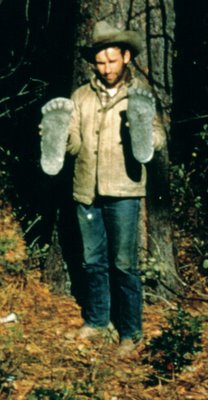
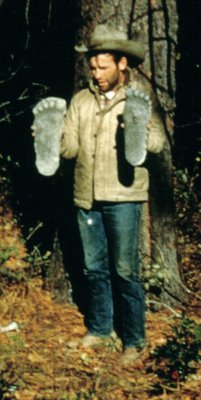
Talking of the photographs above, the so-called “Bigfoot Skeptic” this month writes:
These are the tracks that Patterson claimed the Bigfoot made from his famous 1967 film. Notice the toes. How smooth and perfectly shaped they are. Also notice that despite the deep impression of the foot, the only part of the toe that shows in the plaster is the round tips of the toe. No other part of the toe is seen in the deep plaster cast. This suggests that it was not made by an actual fleshly foot stepping down and putting weight down. Shouldn’t the toes smoosh into each other, not maintain a perfect round form, and show more than just the tips of the toe from such a deep impression?
Okay, first of all, do any of these debunkers do their homework? Do Bigfoot researchers realize part of the problem faced today is the “trophy” mentality and legacy of the early folks who collected Bigfoot track casts? It is good to know as much about the history of these cryptozoological artifacts, as possible, before critiquing them.
A variety of things are going on with the track casts from the Patterson-Gimlin filmsite trackway. Let’s look at two areas to pay attention to, in studying these casts.
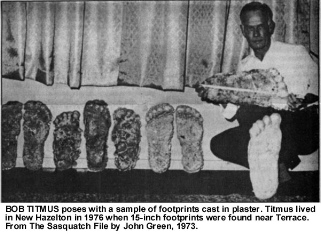
(1) Back in the 1960s, Bob Titmus, who was the taxidermist who first began taking plaster casts of Bigfoot tracks in the Bluff Creek area, had a “trophy” mentality with regard to the footprints being cast. The absolute best track to take and keep was the one that showed the whole foot, he felt.
Most photos from the 1950s and 1960s show Bigfoot eyewitnesses holding up what were considered, at the time, the “best” casts. These were seen as the ultimate proof, because the “whole feet” casts were well-formed and perfect. (We now know the opposite is actually true. The more movement shown in a cast, the more we learn of the real animal.)

The “Patterson-Gimlin filmsite” casts most often sold today (per above) continue a tradition begun by Bob Titmus of picking out the most “perfect” casts.
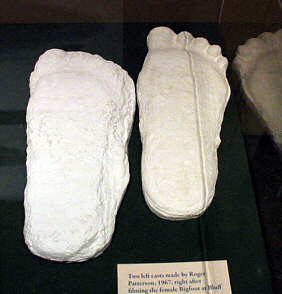
Titmus also treated these “trophy tracks” as items to be “cleaned up” and some of the early letters talk of Titmus “scrubbing up” the casts. He wanted to have them without imprefections, to be presented as white, smooth objects. Titmus, furthermore, actually sold cast copies from the very beginning, and some examples from that time demonstrate the cast surfaces were worked on to look smooth, with plaster edges trimmed.
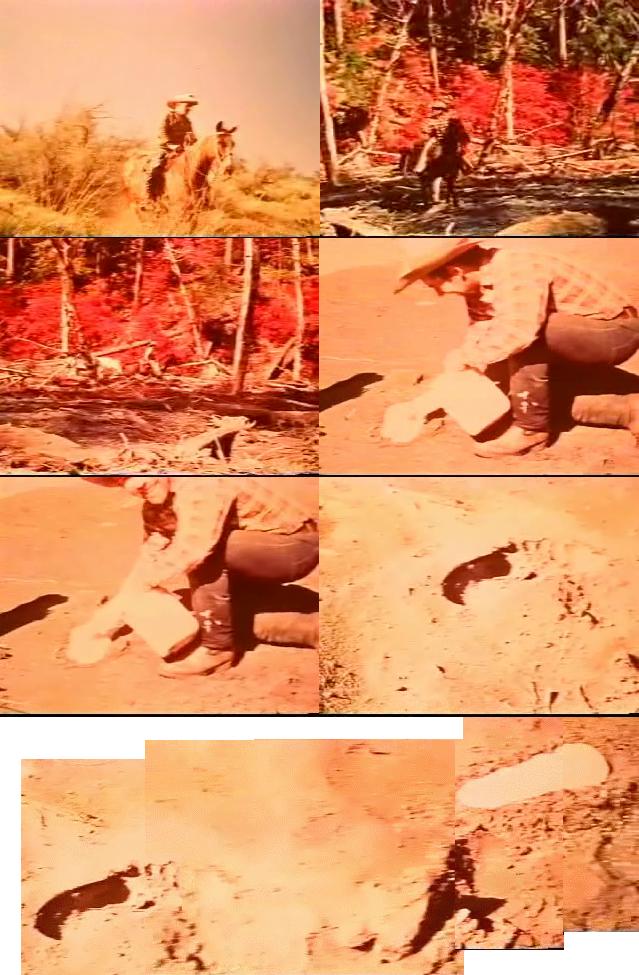
(2) Secondly, and perhaps more importantly in the case of these Bluff Creek tracks, there were more than just the two examples being held by Patterson above.
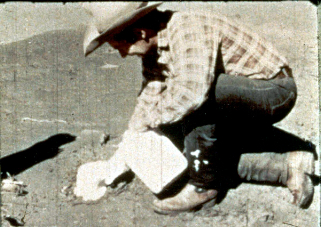
(Go here to view the clip of the film showing Roger Patterson casting these tracks and speaking of his sighting.)
Dr. Grover Krantz and Dr. Jeff Meldrum have both written extensively about how the trackway of where the Patterson-Gimlin Bigfoot walked included a series of tracks. Krantz and Meldrum detailed how the filmsite track casts capture animate feet, not ones that were created by a fixed fake set of feet, as would have been expected with fake feet being used.
The skeptics and debunkers with questions about the Patterson-Gilmin film trackway casts merely have to look at the plaster of Paris imprints and the surviving photos of the filmsite that have been displayed in several books. They show little evidence of fakery, and clearly the tracks were not made by a fixed fake pair of feet.
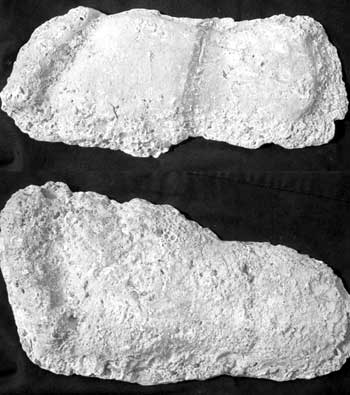
Krantz published the trackway casts in his books.

Meldrum, Chris Murphy, and others have brought forth photographs taken at the time of the varied tracks left at Bluff Creek on October 20, 1967. Meldrum is interested in proving his mid-tarsal break theory, but looking beyond that, study what he has published. Examine how different the tracks are, because it was a live primate, not a man in a suit wearing rigid fake feet.
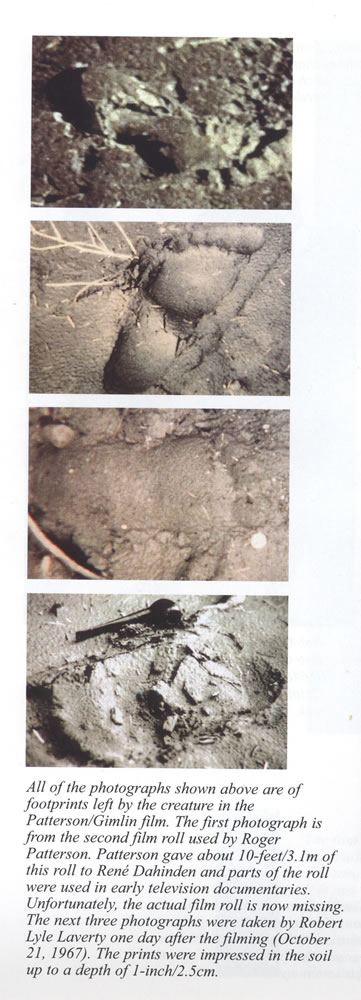
About Loren Coleman
Loren Coleman is one of the world’s leading cryptozoologists, some say “the” leading living cryptozoologist. Certainly, he is acknowledged as the current living American researcher and writer who has most popularized cryptozoology in the late 20th and early 21st centuries.
Starting his fieldwork and investigations in 1960, after traveling and trekking extensively in pursuit of cryptozoological mysteries, Coleman began writing to share his experiences in 1969. An honorary member of Ivan T. Sanderson’s Society for the Investigation of the Unexplained in the 1970s, Coleman has been bestowed with similar honorary memberships of the North Idaho College Cryptozoology Club in 1983, and in subsequent years, that of the British Columbia Scientific Cryptozoology Club, CryptoSafari International, and other international organizations. He was also a Life Member and Benefactor of the International Society of Cryptozoology (now-defunct).
Loren Coleman’s daily blog, as a member of the Cryptomundo Team, served as an ongoing avenue of communication for the ever-growing body of cryptozoo news from 2005 through 2013. He returned as an infrequent contributor beginning Halloween week of 2015.
Coleman is the founder in 2003, and current director of the International Cryptozoology Museum in Portland, Maine.










jerrywayne: some more stuff. But you’re not surprised, I know. 🙂
——————————————————————
“ So, to my mind, taking sighting reports at face value must share the
stage with taking such reports as the artifacts of human witness: faulty at times, fraudulent at times, sometimes culture driven, sometimes mere fantasy driven, etc., etc. (Remember, we DO KNOW that human testimony cannot be trusted always; we DO NOT KNOW that bigfoot truly exist. So which is the truly simplest explanation?”
I said it: that people are seeing what they say they are.
This is a constant skeptical misstep, asserted metronomically but never taken past this point: People are known to be unreliable, so we have to presume that all of these reports are worthless. The obvious conclusion that must be getting drawn: some people lie, fantasize, defraud, etc. Therefore WE MUST PRESUME THAT THEY ALL DO, and thus cannot proceed until a body is dumped in our laps. In no other area of science – nor of life – do we make that presumption; why are cryptids the sole exception? And to reply by saying – as again, skeptics constantly do – that there is no proof is, simply, a circular argument with no logical foundation. Um, just asking: why would you think, given this sort of circular reasoning, that there IS no proof…?
It seems really odd that people think that a large volume of reports, generated by numerous speculated ersatz sources, happen to conveniently behave just like scientific data (which has been demonstrated more than once). What are the odds on that? No one who plays Powerball every day would bet them.
—————————————————
“I think the general public may understand that you cannot have people allegedly tripping over bigfoot all over the place and still have an unconfirmed animal. You have failed to address this central criticism.”
Right. That and many other incorrect public “understandings” contribute to there being no proof yet. And I have addressed this, au contraire, many times. Public ignorance and the associated derision have kept serious science away from this topic, because serious scientists like dealing only with serious people. People are far from “tripping over bigfoot all over the place;” they are not doing this any more than they are other widely distributed animals like mountain lions, porcupines, bears and coyotes. But they are seeing them, in a lot of places. The public doesn’t understand science, by and large; nor does it understand human perception, wildlife, and the out of doors, by and large. (Don’t believe me? Read so-called skeptics. Heck, read many of the proponents!) The idea in quotes above would die quickly if the public understood the relevant topics. Largely, they don’t. The ones that do tend to keep their mouths shut because they just don’t need to hear any more from the ones who don’t. They have what they need.
———————————————————–
“THOUSANDS OF PEOPLE ARE FINDING IT.” Yet, it is not found, not really.
“THOUSANDS” have found something that no one has found (or documented in any concrete fashion).”
Yep, true. Happens all the time, if the history of species discovery offers any context. Scientific proof and personal proof are two different things. Just try telling someone who has the latter that he’s wrong because there’s no former. When nothing else in your life would lead anyone to think you are a crank, why would reporting a sighting suddenly change that? Actually, reading the data, the entire range of sasquatch spoor has been found, at one time or another: everything from feces and hair to footprints and blood. Why no proof? Well, read what happens to all of this stuff when it gets found, almost always by amateurs, and it’s easy to see why. Doesn’t say anything, really, about whether the animal exists or not. Just about how people misuse evidence when they have adopted an a priori negative attitude. Nothing unusual there.
—————————————————-
“I hold out hope for the reality of the PNW bigfoot of yesteryear. Things were so much simpler when bigfoot was truly a rare gem.”
See, that’s your problem. 😉
In the real world nothing is that simple. Fact is, when you’ve really acquainted yourself with the data, the continent-wide sasquatch makes sense; the PNW-only one does NOT. There is no way a wide-ranging largely nocturnal omnivore like this would stay holed up in such a restricted range, anymore than anything else like it (bears, wolves, coyotes, chimps) would. If you presume for this the basic things you presume about other animals whose behaviors seem similar, in similar habitat, you presume an animal with a large range, not a small restricted one.
———————————————–
Is there an “advocate bias” or a “denial bias” attending this issue?
Actually, nothing you say in the paragraph addressing this question has any bearing on whether the animal exists or not. It does, or doesn’t, regardless of what people want to think. I don’t want to talk movies, TV, comic books or tabloids. We have a biological question here. Let’s address that.
—————————————-
“I suggest “people lie”, and your rejoinder: “No, you’re wrong.”
Enough said.”
No. Not nearly. You say “we must presume everyone’s a liar on this topic. (Or mentally ill, or on drugs, or mistaking a bear for an ape. Same thing.)” And you’re wrong. That’s not a logical position to take, on any topic. What’s logical? Thinking people who catch a fleeting glimpse of an ape, in bear country, naturally think, had to be a bear. THAT is logical. You don’t think so? See what I mean about the public not understanding how human perception works?
—————————————
“I suggest we need to shed the omnipresent bigfoot (according to your bigfoot reports) for a far less visible bigfoot for it to be a credible cryptid (a view I share with even some advocates).”
I suggest not. I base my assertion on data. (I’ve already outlined what I mean by that. If you’re not sure: RSR cures all ills.) On what are you basing yours? Many advocates are wrong, badly so, on this topic, because many advocates – like most “skeptics” – are badly informed on relevant topics. I don’t blame the animal’s nonexistence on the missteps of the searchers, because that is blatantly illogical to do.
—————————————————-
“[If you] have bigfoot being “found” by “THOUSANDS” of people, it would NOT be a cryptid!)”
Wrong. I have devoted no more words to any topic on Cryptomundo than I have devoted to debunking that notion. I have done a clear and compelling job, and been ably assisted by others here. It’s blatantly wrong. Thousands of people have found it; and it remains a cryptid. Voila!
And how many times need I say this? Debate this with the scientists who hold open the same possibility I do, i.e., every single one I am aware of who is as informed as I am on this topic. I mean, I’m doing a heck of a job. But one does get tired.
————————————————–
“I care about cryptozoology and have followed the issues involved with it, on and off, for almost 45 years. (Yep, I’m old). I simply think we do it a disservice when we become “believers” prior to confirming evidence. Bigfoot reports, alone, simply are not the “be all” and “end all” of the discussion. Besmirching scientists who point this fact out does nothing to advance the discussion.”
Um, I’m a SKEPTIC. (See, no one knows how skeptics think! Disbelievers in Bigfoot are not skeptics, because this is NOT about belief.) No scientist, acquainted with the evidence, could do his science service by either: (a) saying flat out, without proof, that it’s real; or, (b) dismissing it. Who said anything about being and ending?
—————————————–
“George B. Schaller [etc.]… I, as a skeptic, will go along with Schaller’s point of view. Bigfoot is an open
issue.”
I’m with Schaller. And you too. Exactly. Every word. In fact, my position could not be stated more exactly; nor could anyone doing a thorough read of my posts dispute that.
—————————————-
“If only the advocates would also acknowledge that the existence of
bigfoot is an open issue and not treat the issue as closed (in favor of
bigfoot’s existence), then maybe we all can learn from each other and be friends. [Smile].”
Well, I keep teaching. As you can see, I keep the advocates in line. If you do so with the skeptics, now we’re getting somewhere. 😉
Jerrywayne: missed this one, and as it’s an intriguing opportunity to outline some stuff, here goes.
———————————————-
“DWA, let me tell you about a “sighting” of a different sort. I had a co-worker who told me he had a “sighting” of a creature half man and half horse. I kid you not. He was very sincere. He said he saw the creature at a park and it was walking ahead of him and his friend, only to disappear around a bend on the trail. He was very, very sure of what he saw. He is a honest person. He was a college kid at the time.
Now, what are you to make of this sighting. Dismiss it out of hand? Everyone knows there are no such things as what he claimed to have seen! Hey, I could say the same about bigfoot. Maybe you might say that only two guys saw this animal and thousands have seen bigfoot! True, yet how many folks saw the famous “Dover Demon”? Remember, a sighting is a sighting is a sighting. I vouch for the honesty of this kid who saw a man/horse. So, what is YOUR verdict. (BTW, I got to know this kid pretty well over a year’s time. I was able to talk to him many times over time, a luxury many researchers do not have.)
I was able to solve the centaur sighting to my own satisfaction. Before I reveal my solution, DWA, explain to me please, why you would reject this sighting (as I assume you will).
——————————
My answer: I sure wouldn’t reject it.
Here’s a partial list of things I don’t reject: Bigfoot; alien abductions; ghosts; pyramid power; werewolves; mummies walking at night; humans who can fly; ancient Egyptian curses; Kappa; Mokele-mbembe; thunderbirds; ropen; any cryptid; Jesus Christ as Immortal Ruler of the Universe; etc. etc.
I don’t reject any of those; nor many other things. Because “reject” is the wrong word.
Here’s what I do to that centaur? sighting: nothing.
How many are there? One. Regardless the witness’s standing: ONE. There are any number of reasons that report could have happened. Lie. Hoax. Attempt to mislead for some other reason (like making a Bigfoot doubter his friend). Desire to be thought insane by at least one person. Good drugs. Bad cigarettes. GREAT beer. Optical illusion. Finding out one’s favorite supermodel believes in centaurs.
Etc. Including: just because we consider the centaur a legend doesn’t mean the centaur has to think so.
One sighting.
What, exactly, can one do with it? Where would science be if every single thing every single person reported had to be followed up?
Answer: we wouldn’t have science. We’d only have chaos.
I would only ask – and I can only ask – science to act on things that have lots of evidence to back them up. And only if the evidence looks like real people experiencing a real, plausible thing, external to them, that – and this is key – is susceptible to the process of scientific proof.
If you can show me a Centaur Sightings Database, and those reports read to me like sasquatch reports do – like accounts of real, reasonable people encountering a very specific, uniformly described something they can’t account for otherwise – now I’m saying put it in that database, and let’s see if we have something we can search on.
Otherwise: science has better things to do. Like find the sasquatch. 😉
(Oh. That you were certain I would reject it tells me somebody isn’t reading my posts thoroughly. 😉 )
I really enjoy reading your comments DWA. It must be frustrating when the person you are debating refuses to acknowledge your arguments. I don’t really get how you come to your conclusions jerrywayne. People not just in North America, but across the world are seeing variations of similar creatures and most sightings seems to stay consistent with others in the region. Is everybody going along with it just to annoy the skeptics? Do they all have contact with each other to get the details right? Last, have you ever heard of large scientific expedition mounted by top scientists with large funding going out to search regions with reported Bigfoot activity? No? Well, maybe if it finally happened science would get the conclusive proof it needs instead of the thousands of individual, separate sighting reports. There is so much evidence, not yet proof, but evidence that real scientists should be looking into that I find it appalling. When did science turn its back on its own original principle, to question everything you think you know?